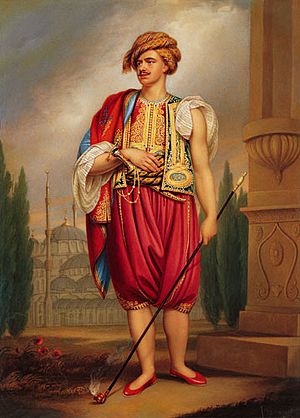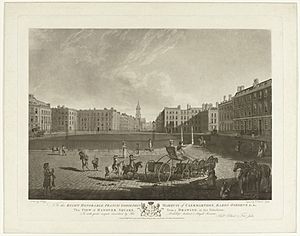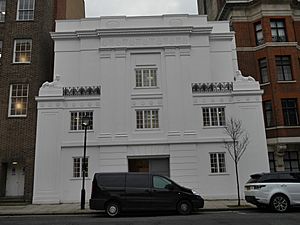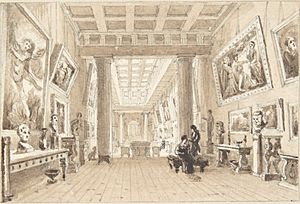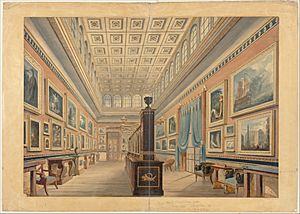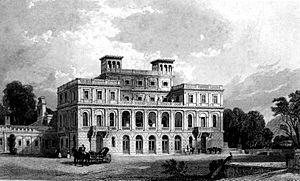Thomas Hope (designer) facts for kids
Thomas Hope (born August 30, 1769 – died February 2, 1831) was a Dutch-British interior designer, traveler, author, and art collector. He was famous for bringing the Greek Revival architecture style to Britain. He also opened his house as a museum and wrote a popular novel called Anastasius. Many people thought his novel was as good as the works of Lord Byron.
Contents
Early Life and Family
Thomas Hope was the oldest son of Jan Hope. His family, the Hopes of Amsterdam, were well-known merchant bankers. He was born in Amsterdam. Thomas had two younger brothers: Adrian Elias, who was a gardener, and Henry Philip, who collected gems and jewelry.
Thomas learned to love art from his parents. His father spent his last years turning his summer home, Groenendaal Park, into a beautiful park with sculptures. It was open for everyone to visit.
Grand Tour Adventures
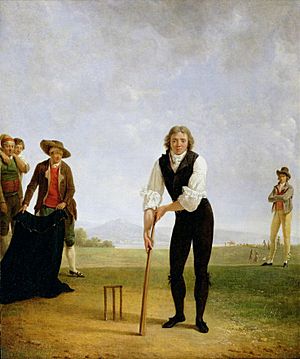
When Thomas was 15, his father passed away. Thomas then started spending more time studying art, especially the architecture of ancient civilizations.
When he was 18, Thomas began an eight-year "grand tour". This was a long trip through Europe, Asia, and Africa. During this journey, he focused on architecture and sculpture. He collected many interesting artifacts, like the Hope Dionysus statue.
After his mother died in 1790, Thomas became a full partner in the Hope company. He owned a large part of the business and was very wealthy. Between 1792 and 1794, he traveled in Italy with his brother Henry Philip, buying ancient art.
In 1794, Thomas had to leave the Netherlands quickly. The French army was invading, and he fled to London to avoid the Batavian Revolution. He never returned to his home country.
Moving to London
The Hope brothers brought 372 valuable paintings with them to London. These included important works by famous artists like Frans Hals, Peter Paul Rubens, Rembrandt, and Sir Anthony van Dyck.
They had to leave their grand homes in the Netherlands, which were full of decorations and statues. Thomas settled in Hanover Square in London. Later, in 1795, the brothers traveled to Rome again.
Their younger brother, Adrian Elias, returned to Groenendaal Park in the Netherlands and expanded its gardens.
A Career in Design
In 1799, Thomas Hope set up his home in London at Duchess Street. He redesigned it in an Egyptian style. Thomas loved the lively atmosphere of London. He decorated his mansion in a very detailed way, with each room having a different style inspired by the countries he had visited.
His house became a showcase for the art collections of his family and the Hope & Co. business. This allowed him to study the art he had seen during his travels even more. Thomas started writing books about decoration and furniture, which were some of the first of their kind.
While his brothers focused on banking, Thomas continued his travels. In 1796, he began extensive tours of the Ottoman Empire, visiting places like Turkey, Egypt, and Syria. He stayed in Constantinople (modern-day Istanbul) for about a year. During this time, he made about 350 drawings of the people and places he saw. These drawings are now in the Benaki Museum in Athens.
In 1801, he bought a collection of Greek vases. Hope & Co. gave him permission to collect many paintings, sculptures, and antique objects during his travels. Some of these were displayed in the company's offices in Amsterdam, and others went to his London house in 1804.
In 1803, he ordered a famous sculpture called "Jason with the Golden Fleece" from the artist Thorvaldsen. Thomas Hope first opened his new art galleries to the public on February 10, 1804.
His "Egyptian Gallery" at home, which displayed his Egyptian artifacts, was a major inspiration for the Regency style of furniture in Britain. His book Household Furniture (1807) showed detailed drawings of his designs.
Marriage and Deepdene Home
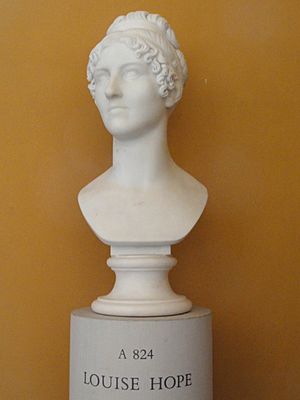
In 1806, Thomas Hope married Louisa de la Poer Beresford. After their marriage, he bought a country home called Deepdene in Surrey. Here, surrounded by his huge collections of art, Deepdene became a popular place for writers and fashionable people to visit. He even had a small library in several languages in each guest bedroom!
Thomas Hope also supported many artists, sculptors, and craftspeople. He helped the Danish sculptor Bertel Thorvaldsen become famous. He also supported Francis Legatt Chantrey and John Flaxman, who illustrated the writings of Dante Alighieri for Hope. He also designed the gardens at Deepdene in a beautiful, natural style.
Thomas Hope was the father of Henry Thomas Hope, who was also an art patron and politician, and Alexander James Beresford Beresford Hope, an author and politician.
Writing Books
Thomas Hope wanted to help people learn more about historical art and design. He also wanted to influence the style of grand houses in London. To do this, he started sketching furniture, room interiors, and costumes. He then published books with his detailed writings.
In 1807, Thomas Hope published Household Furniture and Interior Decoration. This book showed his furniture designs and had a big impact on how houses were decorated. His furniture designs were in a style often called "English Empire," which was inspired by classical art.
In 1809, he published Costumes of the Ancients, and in 1812, Designs of Modern Costumes. These books showed a lot of research into old styles. His book A Historical Essay on Architecture was published after he died in 1835. Because of these books, Thomas Hope became known in London's wealthy circles as "the costume and furniture man."
Here are some of his main books:
- 1807: Household Furniture and Interior Decoration.
- 1809: Costumes of the Ancients.
- 1812: Designs of Modern Costumes.
- 1819: Anastasius, or Memoirs of a Modern Greek. (A novel)
- 1831: Origin and Prospect of Man. (A philosophical work)
- 1835: Historical Essay on Architecture. (Published after his death)
The Novel Anastasius
When he was 50, Thomas Hope started writing a novel after friends suggested it. The first edition of Anastasius was finished in 1819 and published in London. It was later translated into French, German, and Flemish.
The novel helped people understand more about the East. It told the story of Selim, a soldier who becomes a Muslim and travels widely, meeting friends, lovers, and enemies.
Hope's descriptions showed what life was like for people in the Ottoman Empire. It also gave amazing glimpses of wars and described many details of Islamic culture, including music, language, food, religion, laws, and literature.
At first, Thomas Hope did not say he was the author of Anastasius. Surprisingly, many people thought the famous poet Lord Byron had written it. Legend says Lord Byron even cried when he read it, saying he would have given his two most famous poems to have written Anastasius. These events made Hope reveal that he was the real author in later editions.
Even though his family later sold his art collection and his London home was torn down, Anastasius continued to be important. It influenced later writers like William Thackeray, Mark Twain, and Herman Melville. A modern expert, Robert Irwin, said that Anastasius is "one of the most important books of the nineteenth century" and should be read more widely.
Thomas Hope also wrote an important book about philosophy called The Origin and Prospect of Man (1831), which was published after he died. This book looked at the big challenges facing humanity.
In an article written after his death in 1831, it was said that Thomas Hope's writing in Anastasius was so good that it could rival the famous Roman historian Tacitus and even Lord Byron himself. Thomas Hope is still remembered today as "Anastasius Hope" because of his famous novel.
Death and Legacy
Thomas Hope became ill in early 1831 and passed away on February 2 at his Duchess Street home. He was buried on February 12 in the mausoleum at Deepdene.
Sadly, the two grand houses Thomas Hope created are now gone. His Duchess Street house was torn down by his son in 1851, and Deepdene was demolished in 1969. The only complete building built by Hope that still stands is the Deepdene mausoleum. This structure was built in 1818. It was sealed in 1957 and buried in 1960. Today, groups like the Mausolea and Monuments Trust are working to dig up and repair this important structure.
Images for kids
-
Mr Hope of Amsterdam playing cricket; by Jean-François Sablet in Rome (1792).
-
Louisa Hope: bust by Bertel Thorvaldsen (1817)


